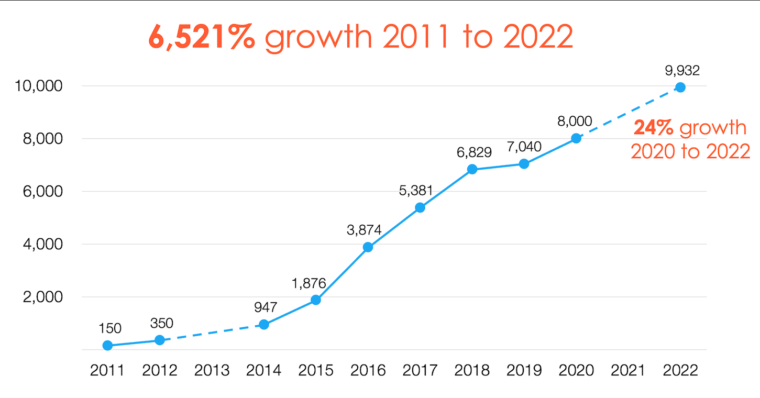I am pleased to announce that Pam Didner, a renowned B2B speaker, author, and consultant, has graciously accepted my invitation to share her expertise on the Golf Business Monitor. Here is her first article.

Technology is fully ingrained into our lives. It’s almost impossible to go completely off-grid now. For example, if you need emergency help, you need your cell phone or GPS to locate exactly where you are.
Martech (Marketing Technology) is also vital for digital marketing communications when almost everyone is getting information through the Internet using their digital watches, phones, tablets, or personal computers.
To keep our finger on the pulse in B2B marketing, we marketers must consider the role of technology as we develop and execute our B2B marketing strategies and demand generation efforts.
Evaluating the technological needs for a successful marketing campaign, especially a global one, can take time and effort. But, building brand awareness and attracting potential customers to a product or service across various marketing campaigns is essential.
That’s why breaking things down into several focused categories is useful for determining an accurate budget. Below, I’ll cover the basics of what you need to know to get started.

Start with a plan, then build out the logistics
No matter how technology evolves, developing a marketing strategy and comprehending an audience’s pain points and goals is an absolute must.
Of course, technology is important when creating a marketing plan. Still, the technology itself is just one piece of a bigger puzzle.
Learning how to articulate the objectives you want your marketing efforts to achieve will help you determine and source the technologies and platforms you need to bring a marketing technology plan to life. And that will remain a constant regardless of where technology takes us in the future.
It sounds like a broken record, but it’s true: start your plan with a clear objective and thoroughly understand your audience as you build it out.
Break it down, now
Once you understand your main objectives and target audience, the best way to evaluate your technological needs is to break down your marketing activity into different channels. Then, build workflows like you would with prospects to move along within your channel.
For example, email marketing is likely part of your overall product launch campaigns. You need to determine when and how emails will affect the product launch.
Look at your product launch timeline, and be sure to ask questions such as, will you:
- Send a teaser email before the product launch?
- Need to send invitation-only emails to targeted accounts?
- Use email to promote the newly launched product?
- Use email as a follow-up for a post-launch survey.
- What else will email marketing play a role in the product launch?
You need to think all of this through very carefully.
Lay your plan out in a timeline sequence to help you, your executives, and internal stakeholders understand the reasoning behind your email marketing efforts.
Based on that, you create your workflows and source content and technologies. In many cases, you already have an email platform in place.
The next question you should ask is how to use technologies to further segment or personalize an email. Or, how can you use technologies to keep the quality of your mailing list up?
For example, with the great resignation and relocation during the pandemic, it’s highly possible to run into the problem of so-called “email decay.”
This happens when email addresses from your mailing list become outdated or terminated. You may need to use 3rd party data enrichment or a data validation platform to validate your mailing list.
The more accurate your mailing list, the better your chances of seeing more successful results across email marketing campaigns.
So, as you can see, almost every step of your marketing efforts requires some technological assistance to boost the success rate.
That’s why many marketers find technologies overwhelming; it’s hard to find out what to use when not to mention how tough it can be to keep up with the latest trends.
Meanwhile, many technology platforms have overlapping features. Since we don’t know the ins and outs of all the features of existing tools that we already use, sometimes we will opt for new technologies instead of using adequate existing ones. Ugh!
Nevertheless, it’s important to break down your campaigns by different channels first. Then, build a workflow on how the channel will be utilized and identify the technologies used at each step.
Consider data flow from technology to technology
In addition, it’s also important to connect technologies.
At the minimal level, your marketing automation tool on the marketing side needs to connect to customer relationship management (CRM) on the sales side.
For example, your email marketing efforts combined with paid advertisements like a LinkedIn ad may drive traffic to a specific website page. You need to understand which channel drives more traffic. You may need to use Pixel or UTM to track each channel’s performance.
Once a prospect lands on the appropriate page to fill out a form, the information on the form may need to be uploaded automatically to the marketing automation tool. You need to make sure that platforms are connected so that you can track the data from one to another.
Success metrics need technology as well
Many marketers don’t realize they also need technology for metric tracking. Yes, you do!
This is especially critical if you want to track MQLs down to the middle and bottom of the purchase funnel.
You want to see if MQLs (Marketing Qualified Leads) make it to become an opportunity within CRM or even if sales can close the deal. If you take on revenue contribution, you need to be able to track your marketing efforts down to the CRM and/or on the sales side.
To do so, you must build a process to monitor your efforts alongside technologies.
Technology is your BFF
There are so many technologies and platforms out there. Chief Martech website estimated 9,932 martech solutions in 2022. It’s up 24% from 2020.

To help marketers understand different martech, they also break everything down into categories.
As I suggest, to identify the technologies you should use, you need to break them down by channels first. Then, bring them together as an integrated campaign to provide a holistic view.
Remember, everyone is struggling with technology.
Here is some good news: if you are overwhelmed by all the various technologies, please remember that you are not alone. We all struggle with it.
Plus, there is no one-size-fits-all solution.
You need to determine what channels your company uses, and then work through the details to identify the appropriate steps and technologies to move forward.
Just as every other aspect of marketing is evolving, so should your martech requirements and needs. If you’d like to take an even deeper dive, don’t hesitate to reach out; I love talking about this stuff, especially when I can help clients get into the nitty gritty of their specific needs.
The origingal article was published on Pam Didner’s blog.
